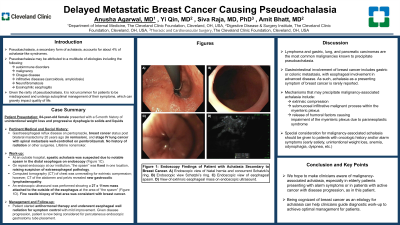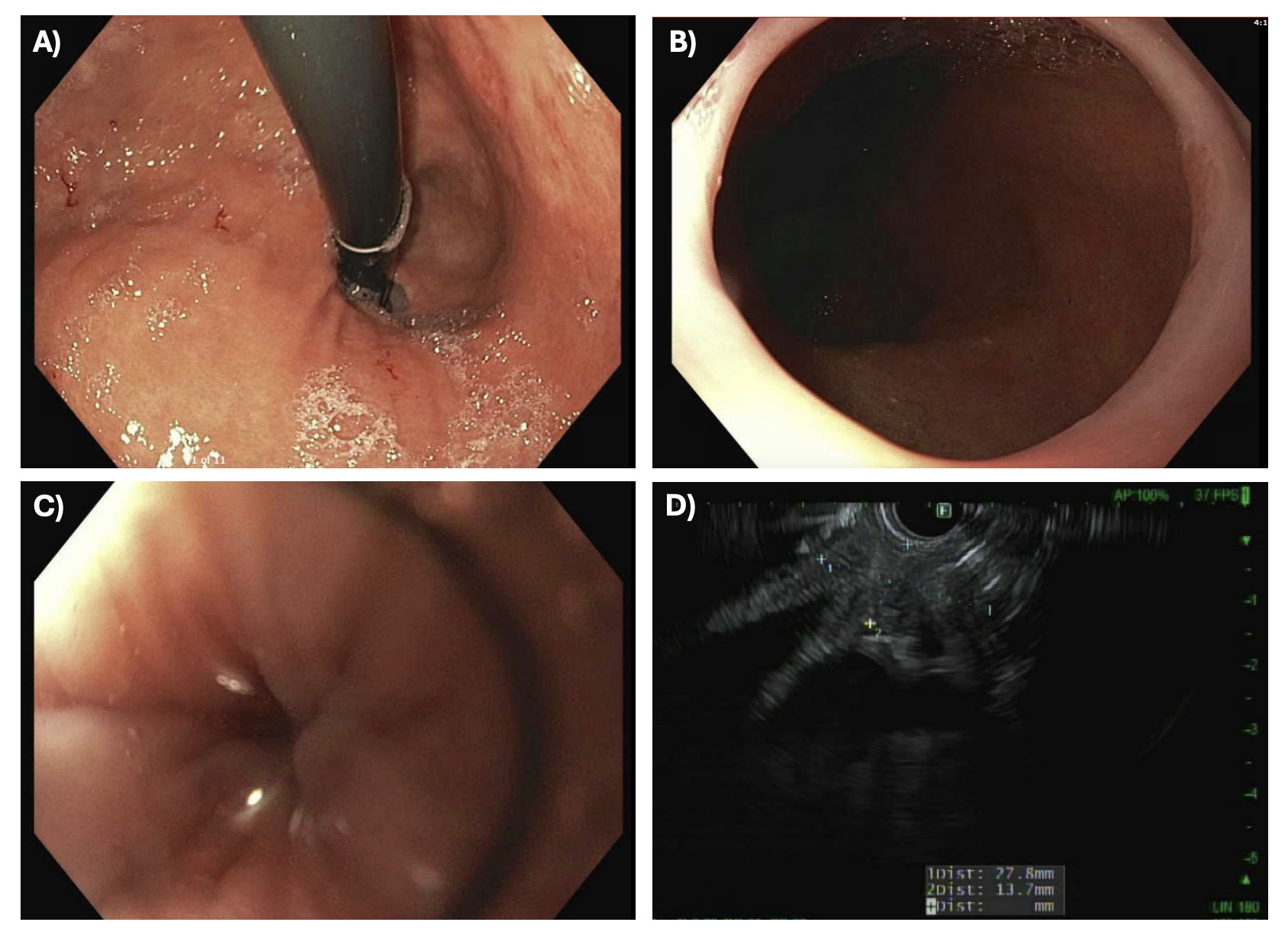Monday Poster Session
Category: Esophagus
P2283 - Delayed Metastatic Breast Cancer Causing Pseudoachalasia
Monday, October 28, 2024
10:30 AM - 4:00 PM ET
Location: Exhibit Hall E

Has Audio

Anusha Agarwal, MD
Cleveland Clinic Foundation
Cleveland, OH
Presenting Author(s)
Anusha Agarwal, MD1, Yi Qin, MD2, Siva Raja, MD3, Amit Bhatt, MD2
1Cleveland Clinic Foundation, Cleveland, OH; 2Digestive Disease Institute, Cleveland Clinic, Cleveland, OH; 3Heart and Vascular Institute, Cleveland Clinic, Cleveland, OH
Introduction: Achalasia is a rare esophageal dysmotility disorder that can stem from a multitude of etiologies. In patients with history of cancer, there should be a higher index of suspicion for malignancy-associated pseudoachalasia. As such, we highlight a peculiar case of achalasia as a presenting symptom of delayed metastatic breast cancer.
Case Description/Methods: An 84-year-old female with history of gastroesophageal reflux disease on pantoprazole, breast cancer status post bilateral mastectomy 20 years ago (in remission), and stage IV lung cancer with spinal metastasis well-controlled on pembrolizumab presented with a 5-month history of unintentional weight loss and progressive dysphagia to solids and liquids. Patient was a lifetime non-smoker with no history of chest wall radiation. At an outside hospital, spastic achalasia was suspected due to notable spasm in the distal esophagus on endoscopy (Figure 1C). On repeat endoscopy at our institution, “the spasm” was fixed in one location, raising suspicion of extraesophageal pathology. Computed tomography (CT) chest was unrevealing for extrinsic compression; however, CT of the abdomen and pelvis revealed new gastrocolic lymphadenopathy. An endoscopic ultrasound was performed showing a 27 x 11mm mass attached to the outside of the esophagus at the area of “the spasm” (Figure 1D). Fine needle biopsy of that area was consistent with breast cancer. Patient started antihormonal therapy and underwent esophageal wall radiation for symptom control with mild improvement. Given disease progression, patient is now being considered for percutaneous endoscopic gastrostomy tube placement.
Discussion: Malignancy-associated achalasia may be attributed to extrinsic compression, submucosal infiltrative malignant process within the myenteric plexus, or release of humoral factors causing impairment of the myenteric plexus due to paraneoplastic syndrome. Lymphoma and gastric, lung, and pancreatic cancer are the most common malignancies known to precipitate achalasia. Breast cancer primarily metastasizes to the stomach or colon. As such, achalasia as a presenting symptom of breast cancer is rarely reported. We hope to make clinicians aware of malignancy-associated achalasia, especially in elderly patients presenting with alarm symptoms or in patients with active cancer with disease progression, as seen in this patient. Being cognizant of breast cancer as an etiology for achalasia can help clinicians guide diagnostic work-up to achieve optimal management for patients.

Disclosures:
Anusha Agarwal, MD1, Yi Qin, MD2, Siva Raja, MD3, Amit Bhatt, MD2. P2283 - Delayed Metastatic Breast Cancer Causing Pseudoachalasia, ACG 2024 Annual Scientific Meeting Abstracts. Philadelphia, PA: American College of Gastroenterology.
1Cleveland Clinic Foundation, Cleveland, OH; 2Digestive Disease Institute, Cleveland Clinic, Cleveland, OH; 3Heart and Vascular Institute, Cleveland Clinic, Cleveland, OH
Introduction: Achalasia is a rare esophageal dysmotility disorder that can stem from a multitude of etiologies. In patients with history of cancer, there should be a higher index of suspicion for malignancy-associated pseudoachalasia. As such, we highlight a peculiar case of achalasia as a presenting symptom of delayed metastatic breast cancer.
Case Description/Methods: An 84-year-old female with history of gastroesophageal reflux disease on pantoprazole, breast cancer status post bilateral mastectomy 20 years ago (in remission), and stage IV lung cancer with spinal metastasis well-controlled on pembrolizumab presented with a 5-month history of unintentional weight loss and progressive dysphagia to solids and liquids. Patient was a lifetime non-smoker with no history of chest wall radiation. At an outside hospital, spastic achalasia was suspected due to notable spasm in the distal esophagus on endoscopy (Figure 1C). On repeat endoscopy at our institution, “the spasm” was fixed in one location, raising suspicion of extraesophageal pathology. Computed tomography (CT) chest was unrevealing for extrinsic compression; however, CT of the abdomen and pelvis revealed new gastrocolic lymphadenopathy. An endoscopic ultrasound was performed showing a 27 x 11mm mass attached to the outside of the esophagus at the area of “the spasm” (Figure 1D). Fine needle biopsy of that area was consistent with breast cancer. Patient started antihormonal therapy and underwent esophageal wall radiation for symptom control with mild improvement. Given disease progression, patient is now being considered for percutaneous endoscopic gastrostomy tube placement.
Discussion: Malignancy-associated achalasia may be attributed to extrinsic compression, submucosal infiltrative malignant process within the myenteric plexus, or release of humoral factors causing impairment of the myenteric plexus due to paraneoplastic syndrome. Lymphoma and gastric, lung, and pancreatic cancer are the most common malignancies known to precipitate achalasia. Breast cancer primarily metastasizes to the stomach or colon. As such, achalasia as a presenting symptom of breast cancer is rarely reported. We hope to make clinicians aware of malignancy-associated achalasia, especially in elderly patients presenting with alarm symptoms or in patients with active cancer with disease progression, as seen in this patient. Being cognizant of breast cancer as an etiology for achalasia can help clinicians guide diagnostic work-up to achieve optimal management for patients.

Figure: Figure 1: Endoscopy Findings of Patient with Achalasia Secondary to Breast Cancer. A) Endoscopic view of hiatal hernia and concurrent Schatzki’s ring. B) Endoscopic view of Schatzki’s ring. C) Endoscopic view of esophageal spasm. D) View of extrinsic esophageal mass on endoscopic ultrasound.
Disclosures:
Anusha Agarwal indicated no relevant financial relationships.
Yi Qin indicated no relevant financial relationships.
Siva Raja indicated no relevant financial relationships.
Amit Bhatt indicated no relevant financial relationships.
Anusha Agarwal, MD1, Yi Qin, MD2, Siva Raja, MD3, Amit Bhatt, MD2. P2283 - Delayed Metastatic Breast Cancer Causing Pseudoachalasia, ACG 2024 Annual Scientific Meeting Abstracts. Philadelphia, PA: American College of Gastroenterology.
